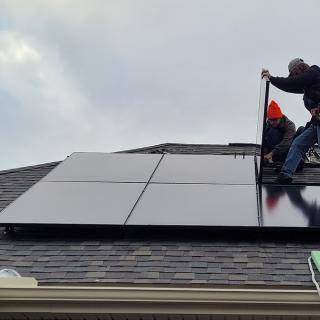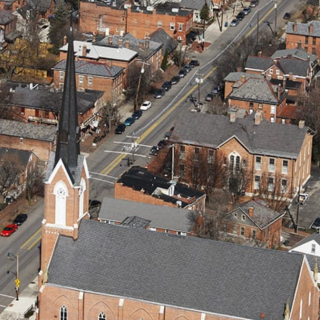COTA’s LinkUS levy (Issue 47) could dramatically change Columbus’s transportation culture, but areas desperately in need of LinkUS’s accordion buses or other solutions may have to wait years before massive traffic messes and congestion is alleviated.
A LinkUS spokesperson last month insisted to the Free Press their levy was mostly about getting residents to good paying jobs. Especially those who don’t have a car or are averse to commuting by car.
And not a moment too soon. On a recent sunny weekday afternoon near Rickenbacker Airport, home to thousands of warehouse distribution jobs, hundreds of commuters were lined up and bottlenecked on Alum Creek Drive’s one lane out of the area at Grove Port Road leading to the two 270 exits just a few hundred feet from this intersection. Even so, the never-ending line of cars suggests quitting time near Rickenbacker may be more tiresome to the hardworking warehouse employees than their actual shift.
By any estimation some of these commuters wait for the light to change green ten times before getting on 270.
True, COTA is currently building a $25 million dollar ten-acre hub at Rickenbacker – or what they call “Transit Supportive Infrastructure” – that should be completed by 2025 (rendering pictured above). The Rickenbacker Mobility Center will be a “last mile” center for people to reach their work site at this sprawling airport considered one of the largest trade hubs on the planet. It will also house a workforce training center, childcare, a food pantry, and bikes to reach far-off warehouses.
The LinkUS levy, however, has two Bus Rapid Transit lines or “BRTs” mapped out, and neither have Rickenbacker in mind. One is for West Broad Street and one for East Main Street, and both should be running by 2030. Both could cost in the hundreds of millions to complete. If the levy passes, it will increase COTA’s share of local sales tax from .5 percent to 1 percent and raise between $6 to $8 billion by 2050.
This levy leaves Rickenbacker out for the foreseeable future, even though South Side activists have warned what a commuting nightmare Rickenbacker has become for workers and how it is getting worse with each new warehouse built.
Bruce Miller, former president of Scioto Southland Civic Association (he recently moved from Columbus), attended a public hearing last November about Rickenbacker’s exploding growth.
“They are building a massive new cargo facility for FedEx, UPS, and the cargo carrier airplanes on airport property, plus three or four new warehouses to be rented out. I told them then during the hearing that this was going to be a total shit show and that traffic was going to be a nightmare,” Miller told the Free Press. “In their 500-plus page written document, the plan during construction was to force traffic to the South High exits off of 270, plus through the heart of the Marion Franklin neighborhood to access Frank Road by using Watkins Road, and to then go past the Marion Franklin Rec Center to hop on to 104. So go up Alum Creek, to Watkins, turn off Watkins on to Lockbourne then onto 104. This forces traffic past multiple schools and residential streets.”
Also concerning is how current and future construction at Rickenbacker will force hazardous materials through these same neighborhoods.
“I objected because the hazmat is getting hauled through Marion Franklin. The old buildings [being torn down] are metal sheds from World War II. They are covered in lead-based paint. Plus asbestos coating. Plus unnamed chemicals from storage of ‘military classified munitions,’” said Miller.
Besides accordion buses racing up and down East Main and West Broad, other corridors are also in a planning stage, such as for Northwest Columbus (Bethel Road). The levy will also fund sorely needed street repairs, more sidewalks, trails, biking infrastructure, and 45 percent more bus service.
“Right now, we have 83 sidewalks, bikeways and trail projects already under consideration that would start as soon as this would be approved by the voter. And those would be built by 2030. And that’s only 150 miles of the 500 miles the LinkUS plan promises. We are hoping to have 150 miles of sidewalks, bike paths and trails done by 2030 with an additional 350 miles to come,” said COTA spokesperson Jeff Pullin to the Free Press.
But for the South Side and Rickenbacker, COTA told South Side advocates they may have to wait a decade or longer for a BRT line. A LinkUS map on its website shows a BRT line connecting John Glenn to downtown to Rickenbacker and designated as a “Planned for Near-term study.”
“The thoughts of our residents were that it doesn’t have a significant impact or cause great improvement to the South Side community,” said Miller. “The projects presented in the plan are disconnected from what [South Side] residents want and or need, and many at the community conversation wanted to know how these projects were selected and why there are so few.”
Mullin responded by saying “these projects take a long time to build” and the West Broad and East Main BRT lines were “a decade in the making.” Currently, the South Side is the only Columbus community with COTA Plus service, which essentially is a ride-sharing service, he says.
“Of the three COTA Plus’s [zones in Westerville, Grove City and the South Side], it is the highest performing and most widely used,” he said. “Because of the success on the South Side, we know that we want to expand to eight other zones as part of the LinkUS plan.”
Miller and others believe the South Side is getting screwed once again for the betterment of other Columbus neighborhoods. This is disconcerting considering LinkUS’s mission is so much about getting people to a good job, such as those at Rickenbacker.
“Overall, the opinion down here is that if passed, it will be the residents of the South Side subsidizing proposed benefits to other portions of the city while our area gets little to nothing with promises of ‘maybe in the future we will revisit your area for review,’” he said.



